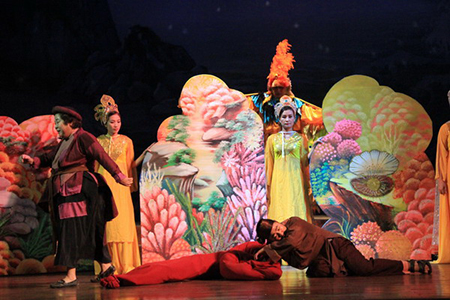Narrative Cheo gives voice to the farmers of the Red River Delta. Its stories differ from those of the classical European theatrical tradition, which evolved from Aristotle. Unlike European narratives, which choose a dramatic event in the life of a character and follow it to its inevitable conclusion, stories involving cheo characters unfold through numerous scenes and activities throughout the hero’s or heroine’s life. As a result, one doesn’t find Aristotle’s dramatic unity of time, place, and action in Cheo drama.

Cheo’s narrative method is not realistic but instead is based on conventions and stylization, similar to tuong and Brechtian staging. Cheo is also rich in folk stories and narration. These characteristics determine cheo’s language. Early skits incorporated songs, dances, gestures, and speech. From these came scenes in the lives of the characters. When combined these scenes formed the body of the play. Cheo does not have the fixed structure of five-act plays, as is the case in the Aristotelian theatrical tradition. Rather, cheo artists frequently improvised during their performance. The play was extended or cut depending on the inspiration of the artists or the requirements of the audience.
Improvisation is important because cheo is an art form that combines speech, singing, dancing, and music to tell a story. Speech may be combined with poems and folk songs. Poems often have two parts and four sentences, with characters displaying their own way of reciting lines. When singing, artists must pronounce their lines clearly (cheo differs from tuong in this respect) to express the character’s feelings. Unlike European opera in which a singer must memories arias and perform them according to the directions of the conductor, cheo artists are free to modify their songs to convey their characters’ emotions. The number of cheo airs is undetermined, but according to estimates, there may be more than 200. The minimum accompaniment for cheo singing is two string instruments, the nguyet and nhi, and a flute. Musicians use percussion – especially drums and cymbals – to add excitement; they beat small drums to maintain the rhythm for dancing and singing.

